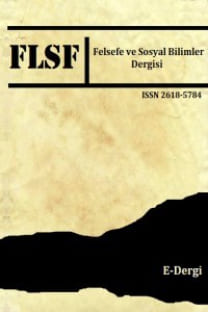EXEMPLARITY OF DIFFÉRANCE
Husserl’in fenomenolojisi üzerine erken dönem araştırmalarından itibaren Derrida’nın metin okumaları yazının söze ve logos’a farkına différance olarak gönderme yapar. Ve eğer différance gönderme ise, bu, onun her bir metin kertesinde bulunuşunda kendini misal olarak bulmasından ileri gelmektedir. İster Husserl’in geometrisinde, ister Platon’un pharmakon’unda ya da Kant’ın parergon’unda olsun, fark, bu kavramların kendilerini anlamlarının ertelenmesi vesilesiyle başka kavramlara tehir ettikleri différance misali olarak kendini taşır. Bu yüzdendir ki Husserl’de göstergesel anlamın manaya olan farkı sesin canlı olarak huzurda oluşunu tecil eder. Derrida Husserl’in kendini yazıda mücessem kılan bu farkı nasıl muallaka/askıya aldığını gösterir — her ne kadar bu fark huzurda olan canlı mevcudiyetin yararına tecil edilse de. Platon için de, canlı olarak huzurda oluşun bu sefer de logos’a olan farkı yazının olduğu pharmakon’da misalini bulur. Pharmakon’da canlı sesin (yaşam olarak) zoē’si bir nevi vekil zoē olarak, bu sefer aynı zamanda resim demek olan zoē anlamında, logos’un sürgün edilmiş temsili olarak tefrik eder. Kant’a gelinceyse, parergon, her ne kadar güzelin yüceye olan farkını misalsi bir şekilde misallendirse/temsil etse de, ve her ne kadar orada misaller tam da güzelin “izahı” için kullanılsa da, neticede, yüce yasa misalinde, Derrida’nın titizlikle hatlarını çizdiği şekliyle, yasanın vaz edilişinde yasanın, misalinin yasa ile olan farkı sayesinde tehir ve tefrik ettiğine işaret etmeye kadar gider. İşte ancak bu (nevi) misallerin misalsiliklerinden itibaren Derrida bu farka “misalsiz misal” diyebiliyordu. Ve işte ancak Derrida tarafından sunulmuş bu misallerin tehirinden sonradır ki bu makale de différance’ın bu misalsiliğini “misalin misali” olarak vaz edebilirdi. Ve böylelikle de gelecek bir inceleme için hipotez olarak sunulabileceği kadarıyla, Kant’tan Husserl’e ve de oradan da Derrida’ya dek uzanan yaşam misalinin, “misalsiz misal” paradigmasının (Derrida’nın metninin de misalini verdiği) “misalin misalini” tehir ve tefrik ettiği o misalin misalsiliğine tekabül ettiği söylenebildi.
Anahtar Kelimeler:
Jacques Derrida, Edmund Husserl, différance, misal, epokhē
EXEMPLARITY OF DIFFÉRANCE
Since his early investigations on Husserl’s phenomenology, Derrida’s reading of the texts refers as différance to the difference of writing to speech and logos. And if the différance is reference, it is because every time it finds its instance in a text, it finds that as an example. Be it Husserl’s geometry, Plato’s pharmakon or Kant’s parergon, difference bears itself as the example of différance in which these concepts are deferred to other concepts by means of the delay of their signification. That is why in Husserl, the difference of signification to meaning makes the living presence of the voice deferred. Derrida shows how Husserl suspends this difference that is incorporated in the writing itself, though this difference is deferred for the sake of living presence. For Plato too, the difference of living presence this time to logos finds its example in the pharmakon that the writing is. In pharmakon the zoē [life] of living voice is diferred as a substitute zoē, which means also painting, a relegate representation of logos. As to Kant, the parergon, although exemplifying the difference of the beauty to the sublime in an exemplary way, and although there the examples serve as “clarification” itself for the beauty, cannot but point to the example of sublime law through which Derrida meticulously delineates how the law itself is positioned in and through the difference of the example of law to law. It was only by the exemplarity of these examples that Derrida could call this difference as the “example without example”. And it was only after the deferral of those examples offered by Derrida that this paper could propose to pose this exemplarity of différance as the “example of example”. And whence it is offered as a hypothesis to come (for future analysis) that, from Husserl to Kant, the example of life was also the example of exemplarity through which the paradigm of the “example without example” deferred and differed the example of the example” that Derrida’s text exemplified.
Keywords:
Jacques Derrida, Edmund Husserl, différance, example, epokhē,
___
- Agamben, Giorgio. Homo Sacer. Il potere sovrano e la nuda vita. Torino: Giulio Einaudi editore. 1995.
- Badiou, Alain. Loqiques des mondes. Paris: Seuil. 2006.
- Derrida, Jacques. De la grammatologie. Paris: Minuit. 1967.
- Derrida, Jacques. La dissémination. Paris: Seuil. 1972.
- Derrida, Jacques. Marges de la philosophie. Paris: Minuit. 1972.
- Derrida, Jacques. La vérité en peinture. Paris: Flammarion. 1978.
- Derrida, Jacques. La carte postale. De Socrate à Freud et au-delà. Paris: Flammarion. 1980.
- Derrida, Jacques. Spectres de Marx: L’Etat de la dette, le travail du deuil et la nouvelle internationale. Paris: Galilée. 1993.
- Derrida, Jacques. “Introduction”, in L’origine de la géométrie. Paris: Presses Universitaires de France. 1995.
- Derrida, Jacques. Séminaire Le respect (7th seance) [unpublished seminar], Jacques Derrida papers. MS-C001. Special Collections and Archives, The UC Irvine Libraries, Irvine, California.
- Foucault, Michel. Les mots et les choses. Une archéologie des sciences humaines. Paris: Gallimard. 1966.
- Kant, Immanuel. Critique of the Power of Judgment (P. Guyer, E. Matthews, Tr.). New York, NY: Cambridge University Press. 2000.
- Kant, Immanuel. Critique of Practical Reason (M. Gregor, Tr.) (14th Ed.). Cambridge: Cambridge University Press. 2015.
- Nancy, Jean-Luc. “Insacrifiable”. In Une pensée finie. Paris: Galilée. 1990.
- Yayın Aralığı: Yılda 2 Sayı
- Başlangıç: 2006
- Yayıncı: Hamdi BRAVO
Sayıdaki Diğer Makaleler
RADİKAL DEMOKRASİ VE POPÜLİST SİYASETİN ÖZNESİ OLARAK HALK’IN İNŞASI
KİŞİSEL İYİYLE İLGİLİ ARZU TEORİLERİNİN DEĞERLENDİRİLMESİ
FELSEFİ ANTROPOLOJİ’NİN GEREKLİLİĞİ VE MAX SCHELER’İN FELSEFİ ANTROPOLOJİ’SİNİN DEĞERLENDİRİLMESİ
HEIDEGGER’İN BERGSON’UN ZAMAN GÖRÜŞÜNE YÖNELİK ELEŞTİRİSİ ÜZERİNE BİR ELEŞTİRİ
NIETZSCHE’S EARTH: THE GROUND OF VALUATION IN THUS SPOKE ZARATHUSTRA
SCHELLING’İN MUTLAK ÖZDEŞLİK DÜŞÜNCESİ
BİR İMKANLAR FİLOZOFU OLARAK NIETZSCHE: MEVCUT POLİTİK KRİZE ALTERNATİFLER
